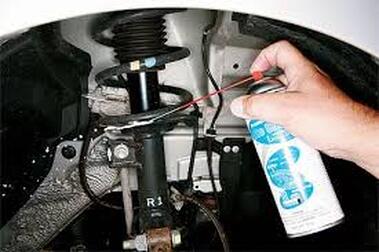 by P Sanchez Does your beloved car squeak and creak when driving over a rough patch of road? Is your car showing its age and you’re longing for the days of quiet ride and confident handling? Is this line of questioning starting to sound like an introduction to a cheesy infomercial for a cure-all automobile product? Well, it’s not because we’re continuing our little discussion on understanding those annoying sounds our car aging cars make. Last time, we talked about possible causes of squealing sounds while driving. This installment will be about squeaks and creaks in your suspension, often very nefarious in the difficulty of isolating the exact source, sometimes even for mechanics. Let’s dive in.
Passing The Joint (Inspection) Your car’s suspension system functions to cushion the ride, improve road holding and handling, and in conjunction with the steering system, provide the driver a means to “steer” the vehicle, all while supporting the vehicle on all wheels. This means the suspension system has to allow the wheels and body of the vehicle controlled movements which it does through links and joints. And these joints need lubrication between their mating surfaces to avoid wear. Without lube, you got your squeaks and creaks Ball-joints are like your pelvic and shoulder joints, they allow for a wide range of movement in multiple planes. Examples would be the end of the lower control arm. These are encased in grease using a rubber boot. These boots deteriorate with age and once they do, the grease dries out and you’ll start getting them squeaks. Bushings are used in joints that only do a limited amount of motion and they are the most common joints in your suspension. Most are rubber cylinders or sleeves that allow rotational movement. If you have a rear trailing arm suspension in the rear (like with most front wheel drive cars), one easy to spot bushing is the bottom end connection of your rear shocks. These also need lubrication to stay quiet and avoid wear. Rubber mounts are probably the simplest movable joint. An engine mount is a common example and it’s so designed to accommodate only a limited movement as well as sound and vibration deadening qualities. Damages mounts can also happen which can also create squeaks and creaks. Thanks for the Crash Course But How Do I Fix It? Bear in mind that noises from your suspension are best addressed by a qualified mechanic. You always want a permanent solution else the problem can worsen necessitating costlier repairs. But there are a few things you can do to avoid getting the problem in the first place, or at least if you’re curious to know, troubleshooting you can do to identify the erring joint and give a temporary fix until you get your car professionally repaired. You can visually inspect the joints. Any drying or tearing of rubber parts like boots and bushings is a tell-tale sign. Tearing can cause the lubricant to dry-out and it can introduce abrasive dirt to the mating surfaces. One preventive maintenance practice is protecting the rubber parts of the joints. As these tend to dry out over time, you can spray them with rubber protectants. There are a lot of these rubber protectants available in the market like 303 UV Protectant spray or AT-205 Re-Seal which are specifically designed for rubber. A lot of mechanics swear by these products in making rubber components last longer. Of course, lubricating suspect joints is common troubleshooting. If lubing quiets things down, then you might have just then found your faulty joint. For joints that have rubber components, it’s advised to use silicone based lubricants. Petroleum-based lubricants can cause the rubber parts to deteriorate. A nice heaping of silicone spray on all joints is also a good preventive measure. How about WD-40? There’s much debate about the safety of the venerable penetrant spray on rubber parts. WD-40 is hydrocarbons based (same chemistry as petroleum derivatives) but the company of WD-40 itself claims that their latest formulation will not harm synthetic rubber. Realize however that WD-40 is still a solvent, meaning any lubricating benefits it brings is temporary at best, and at worst, it may dissolve and dry-out the heavy lubricant or grease originally put-in to cushion and lubricate the joints, eventually exposing the metallic mating surfaces to wear. So WD-40 can be a troubleshooting tool but not a preventive measure or even a temporary fix. Conclusion Every bit of information will help your mechanic with repairing your squeaky suspension. Which wheel well is the noise coming from? Is it happening when hitting bumps and potholes? Is it when braking? Does it appear during certain speeds? Is it there when doing wide turns (body roll) or does turning the wheel even when stationary causing the sound? You can try a few things to zero in with the problem and address these noises early on to avoid costlier repairs.
2 Comments
Andrew
6/14/2022 08:47:41 pm
I enjoyed this series a lot. Full of value. I want to share a company that gets my car servicing needs. "Governor Automotive". https://governorautomotive.com.au They provide roadworthy certificate, truck servicing, and exhaust repairs very well! Thank you once again!
Reply
Leave a Reply. |
AuthorSmith's Auto Repair serves Dayton, Ohio and the surrounding communities using digital inspection service for all its customers ArchivesCategories |
 RSS Feed
RSS Feed